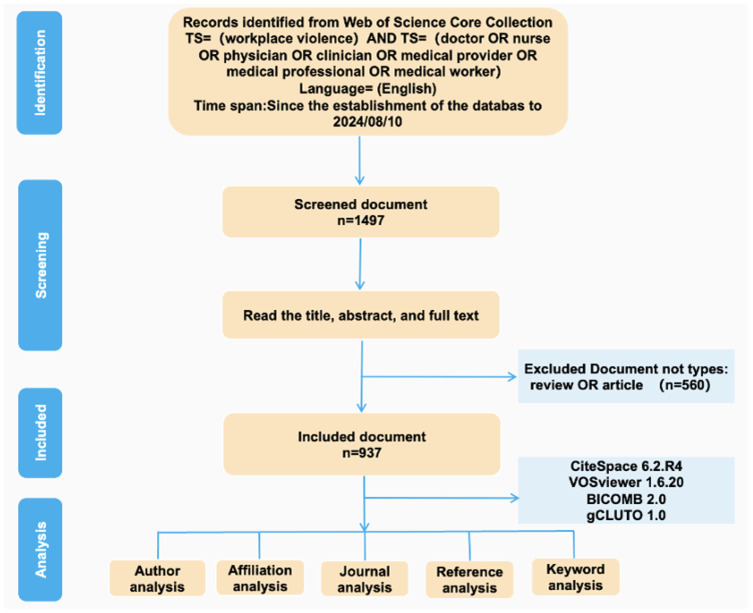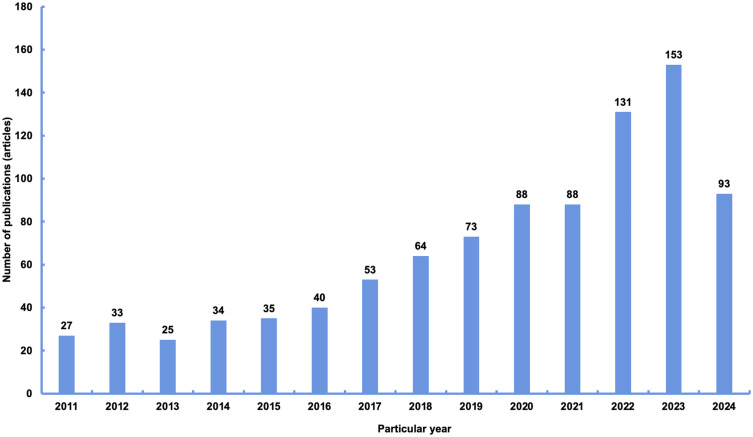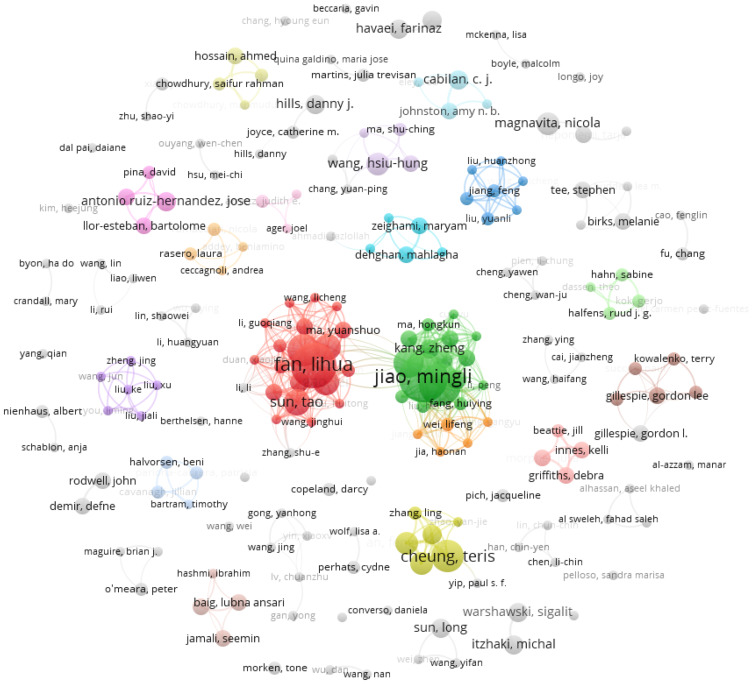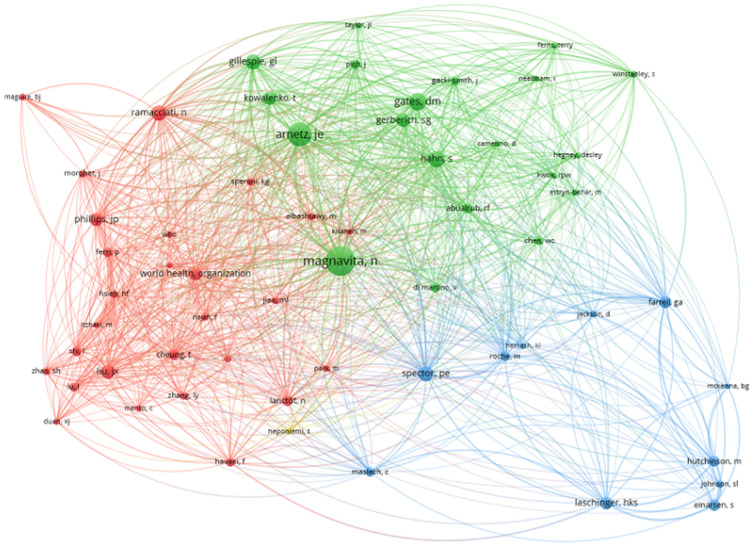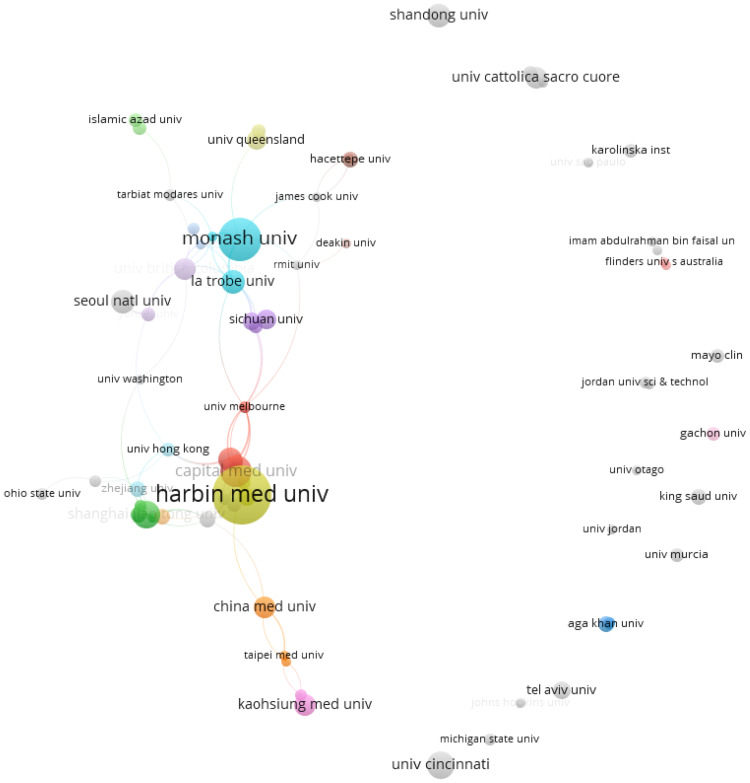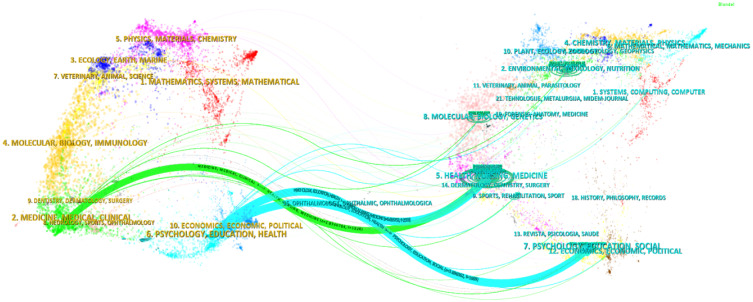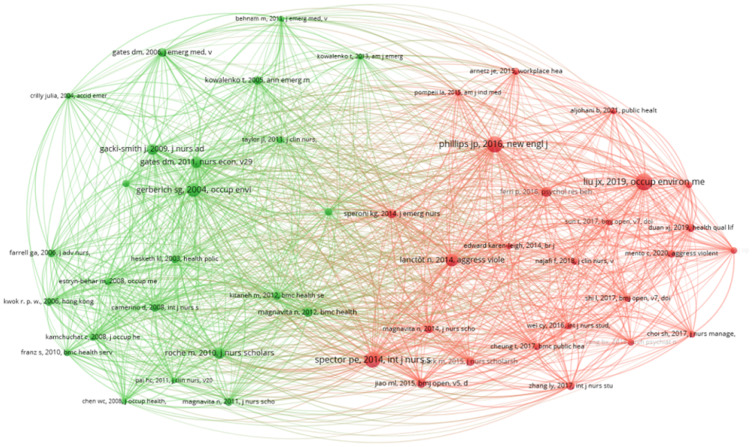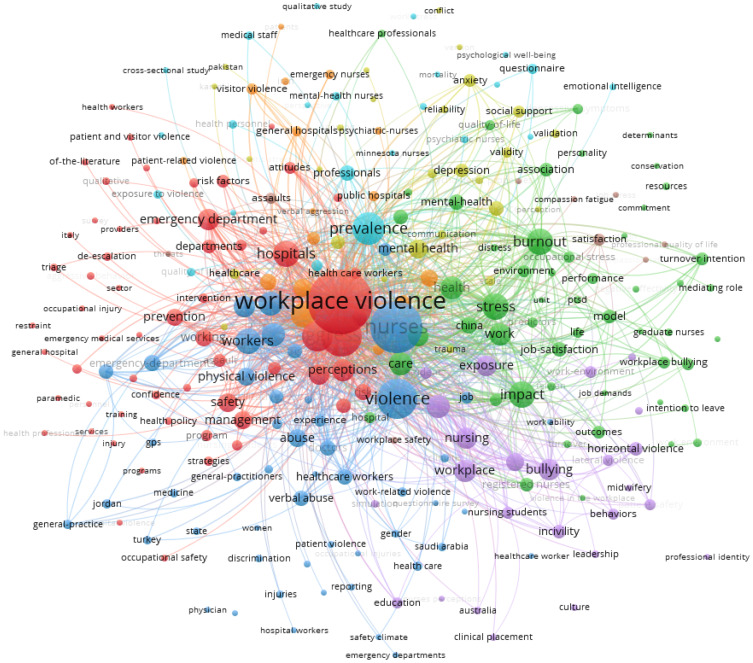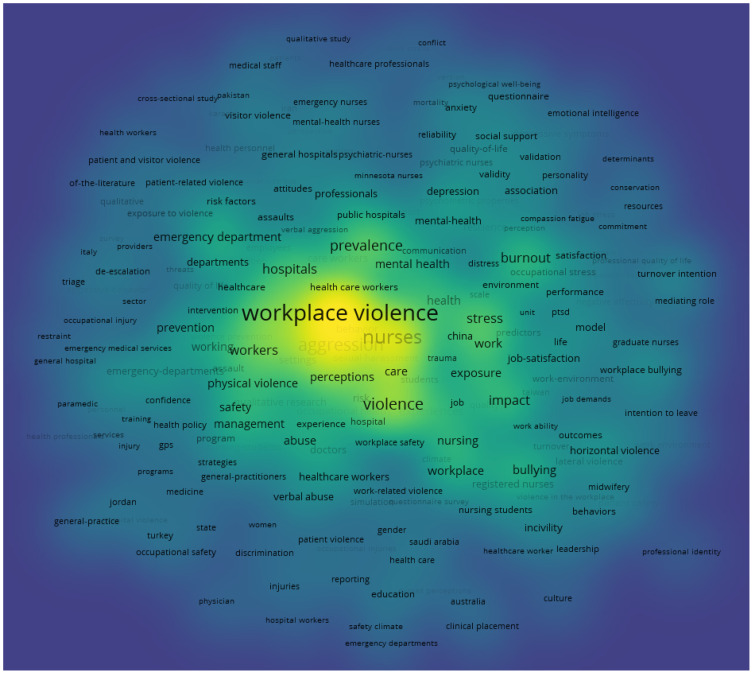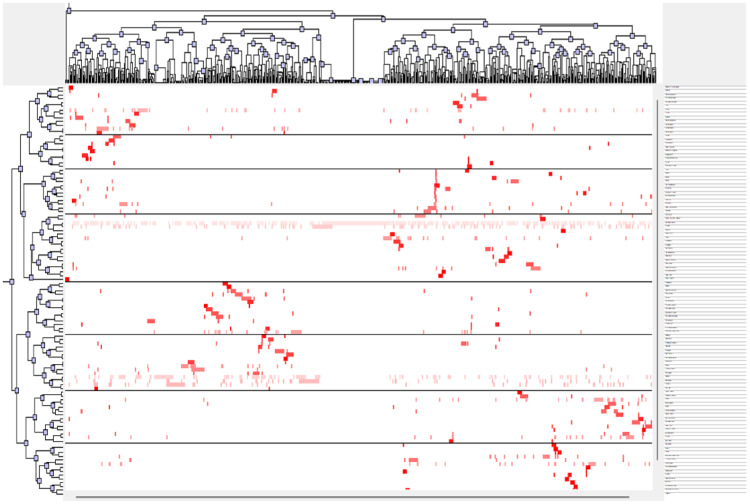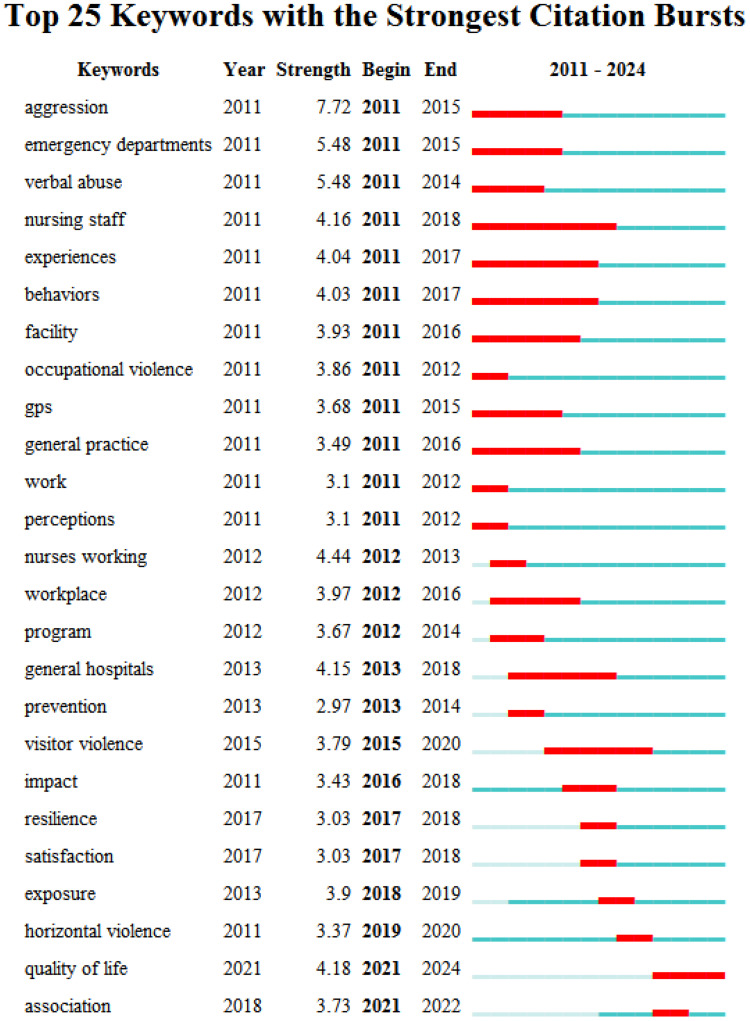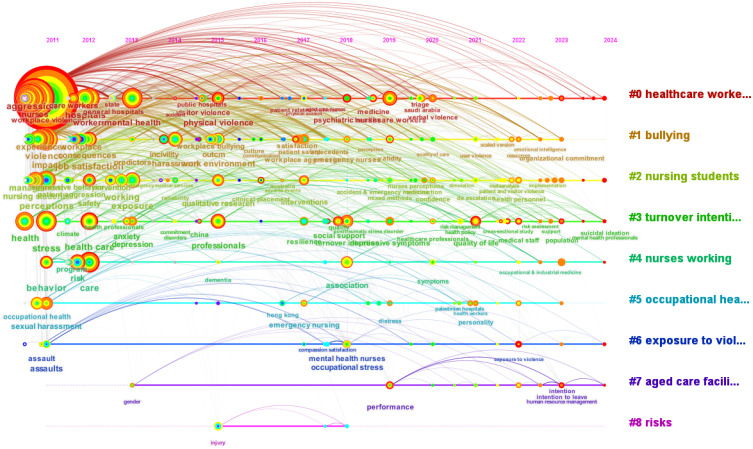Abstract
Background
Workplace violence is a significant issue in healthcare settings, affecting the physical and psychological health of healthcare professionals and compromising patient care quality. Despite growing concerns, a comprehensive understanding of the research landscape remains limited.
Objective
This study aims to analyze the research hotspots and trends in workplace violence among healthcare professionals through bibliometric and visualization analysis, providing insights into the current state of research and identifying future directions.
Methods
We conducted a comprehensive search of the Web of Science database from inception to August 10, 2024, identifying relevant studies on workplace violence among healthcare professionals. A total of 937 publications were included for analysis. Bibliometric and visualization analysis software (CiteSpace, VOSviewer, BICOMB, and gCLUTO) were used to analyze authors, affiliations, and keywords, and to visualize research trends and hotspots.
Results
Our analysis revealed 9 distinct clusters of research hotspots, including risk factors, affected departments, demographics, and impacts of workplace violence. Key findings indicate that emergency departments and nursing staff are particularly vulnerable, with significant impacts on mental health and job satisfaction. The study also highlights the increasing trend of publications over the years, reflecting growing research interest in this area.
Conclusion
The findings reveal that workplace violence is a significant issue affecting the mental and physical health of healthcare professionals, with notable impacts on job satisfaction, patient care quality, and overall organizational climate. Future efforts should focus on strengthening collaborations and developing targeted interventions to mitigate workplace violence, thereby enhancing the safety and quality of healthcare services.
Keywords: healthcare professionals, workplace violence, research hotspots, bibliometric analysis, visualization analysis
Video abstract

Point your SmartPhone at the code above. If you have a QR code reader the video abstract will appear. Or use: https://youtu.be/GZU-8awRhQk
Introduction
Workplace violence refers to various forms of violent behavior occurring in professional environments, including but not limited to verbal abuse, threats, physical assaults, discrimination, sexual harassment, and other forms of intimidation or aggression.1,2 These violent acts are typically initiated by colleagues, supervisors, clients, patients, or the public, posing potential threats and harm to the physical and psychological health of workers.3 The origin of workplace violence research can be traced back to the early 1980s when societal concerns about safety and health in work environments began to escalate.4 Initial studies primarily focused on industrial sectors, particularly high-risk occupations such as police officers, firefighters, and security personnel, investigating incidents of workplace violence.5 These studies highlighted the profound impact of violent events on professional life and personal health, prompting scholars and policymakers to address the nature of workplace violence and strategies for prevention.6 Over time, research on workplace violence expanded into other sectors, notably service industries and healthcare.7,8
The research progress on workplace violence among healthcare professionals highlights its severity and complexity within healthcare environments. Healthcare professionals, especially nurses and doctors, often face physical and verbal violence from patients and their families, posing threats to individual health and psychological well-being, and impacting the quality and efficiency of healthcare services.9,10 Early studies primarily focused on describing and quantifying the types, frequency, and impacts of violence experienced by healthcare professionals.11 These studies indicate that workplace violence encompasses not only physical assaults but also verbal threats, intimidation, and sexual harassment, significantly affecting victims’ mental health and job satisfaction.12,13 As research progresses, scholars have explored the mechanisms and underlying factors of workplace violence, closely linking it to factors such as job stress, complexity of patient care, workplace safety, and management practices.14 These studies not only aid in understanding the causes of violent incidents but also provide a basis for developing effective prevention and intervention strategies.15 In recent years, research on workplace violence among healthcare professionals has expanded into interdisciplinary and cross-cultural perspectives. Integrating disciplines such as psychology, sociology, and public health helps comprehensively understand the impact of violence on healthcare professionals’ health and organizational climate.16 Moreover, cross-cultural comparative studies reveal differences in types of violence and coping strategies among healthcare professionals from different cultural backgrounds, offering insights for tailored policies and training programs.17
A series of studies indicate that workplace violence will have profound effects on the occupational health and well-being of healthcare professionals. Firstly, violent incidents may threaten the physical health of healthcare professionals, including injuries, bodily harm, and other physical damages.18 Such physical injuries not only directly impact their work capability and efficiency but may also lead to long-term health issues and disabilities.19 Secondly, violent events also significantly affect the psychological health of healthcare professionals.20 Healthcare professionals who endure long-term exposure to violence may also experience burnout and emotional fatigue, affecting the continuity and stability of their careers.21 Additionally, violent incidents influence the work attitudes and behaviors of healthcare professionals. Those affected by violence may lose enthusiasm and focus at work, develop defensive attitudes towards patients and the work environment, and even exhibit avoidance or refusal emotions towards their duties.22 Such changes in attitude and behavior not only impact individual professional performance but may also affect team cooperation and work efficiency.23 Moreover, violent incidents can adversely affect the quality and safety of healthcare services. Healthcare professionals who experience violence may struggle to provide effective nursing and medical care, thereby affecting patient treatment outcomes and satisfaction.24 These impacts not only pose challenges to the personal career development and job satisfaction of healthcare professionals but may also damage the reputation and trust of the entire healthcare institution.
Bibliometrics and visualization analysis play crucial roles in scientific research. Bibliometrics analyzes extensive literature data to reveal research trends, hot topics, and academic impact in specific subjects or fields.25 It quantifies and evaluates the influence and associations of research outcomes through citation analysis, keyword analysis, and co-citation networks, aiding researchers in understanding the structure and evolution of academic domains.26 Visualization analysis transforms complex literature data into graphical displays, presenting relationships and patterns within research areas in an intuitive and clear manner.27 For instance, network diagrams and heat maps illustrate collaboration networks, topic distributions, and research hotspots, facilitating rapid comprehension of significant trends and relationships within the field.28 This visualization approach not only promotes knowledge discovery and communication but also guides future research directions and strategies.
Therefore, to accurately grasp the dynamics and developmental trajectory of workplace violence among healthcare professionals, this study focuses on the progress of research in this area. This study aims to address the following key questions: (1) How have the annual publication and citation trends in the field of workplace violence among healthcare professionals evolved over time? (2) Which journals and authors are the most productive and influential in the field of workplace violence among healthcare professionals? (3) How are the collaboration networks among authors and their affiliations researching workplace violence among healthcare professionals structured? (4) What are the keyword occurrence and co-occurrence patterns in the field of workplace violence among healthcare professionals?
Materials and Methods
Data Source
This study utilized the Web of Science Core Collection (Clarivate Analytics) as the primary data source due to its comprehensiveness and authoritative status. This database includes over 12,000 international academic journals and is widely recognized for its robust information retrieval capabilities.29,30
Search Strategy
We searched the Web of Science database using the following criteria: (1) TS=“workplace violence” AND TS=“doctor OR nurse OR physician OR clinician OR medical provider OR medical professional OR medical worker”; (2) Document type = review or article; (3) Language = English; (4) Search date = from database inception to August 10, 2024. The search yielded 1497 documents, which were screened by two independent researchers. Discrepancies were resolved through discussion or by a third reviewer if consensus was not reached. Ultimately, 937 studies were included for analysis (Figure 1).
Figure 1.
Flowchart of the literature on workplace violence among healthcare professionals.
About Text Preprocessing
We used CiteSpace (version 6.2.R4, Drexel University) for text preprocessing to analyze collaboration networks and visualize research topics. This tool supports co-citation analysis and provides a user-friendly interface with features like timeline visualization.31
In this study, VOSviewer (version 1.6.20) was used for its robust bibliometric analysis capabilities and minimal data preprocessing requirements. It integrates VOS mapping and advanced visualization into a user-friendly program, emphasizing graphical representation for large bibliometric maps. For example, it efficiently constructs co-citation maps involving major scientific journals. This highlights its superiority over traditional methods in capturing current trends in science and technology.32–34
We also used BICOMB (version 2.0) to document and categorize the prevalence of principal and secondary keywords, creating a matrix that highlights their co-occurrence.35
The co-occurrence matrix was analyzed using gCLUTO (version 1.0), a clustering tool developed by Matt Rasmussen and Mark Newman at the University of Minnesota, which offers hill and matrix visualizations. For analysis optimization, documents were exported as Plain Text Files containing author names, titles, sources, citation counts, accession numbers, and abstracts. Processing parameters were set with an annual interval from 2011 to 2024, using full citations and citation references.
Data Analysis
During data extraction, we exported complete records and citations in Plain Text Files and manually standardized the data to ensure precise analysis. Publication journals and citation counts were used as primary quality indicators. Data were then encoded and digitized for further processing.
In data analysis, we focused on six key dimensions: (1) global and annual publication trends; (2) author analysis, highlighting prolific authors and co-citation frequencies; (3) affiliations analysis, identifying high-output institutions; (4) journals analysis, examining their role and impact; (5) reference co-citation analysis, exploring interconnections among cited references; and (6) keywords analysis, emphasizing prevalent and significant keywords.
Results
Global and Annual Publication Trends
This study included 937 articles on workplace violence among healthcare professionals. Publications began in 2011 and showed an overall increasing trend, with a peak of 153 articles in 2023, indicating growing research interest in this area (Figure 2). A slight dip in publications was observed between 2012 and 2013, but the trend remained stable As of August 10, 2024, there were 93 publications in 2024.
Figure 2.
Line graph of publication counts on workplace violence among healthcare professionals.
Authors Analysis
Author Publication Analysis
This analysis included 3608 authors, with the top 20 authors listed in Table 1. According to Price’s Law, core authors were identified as those with ≥3 publications (N=0.749 , N is the minimum number of publications for core authors, and n max represents the maximum number of publications by any single author).36 The most prolific author was JIAO MINGLI with 15 publications, followed by FAN LIHUA with 14. These authors form a core research team, though limited collaboration is observed among them (Figure 3).
, N is the minimum number of publications for core authors, and n max represents the maximum number of publications by any single author).36 The most prolific author was JIAO MINGLI with 15 publications, followed by FAN LIHUA with 14. These authors form a core research team, though limited collaboration is observed among them (Figure 3).
Table 1.
Top 9 Authors by Publication Count on Workplace Violence Among Healthcare Professionals
| Rank | Author | Publications | Citations | Total Link Strength |
|---|---|---|---|---|
| 1 | JIAO MINGLI | 15 | 514 | 59 |
| 2 | FAN LIHUA | 14 | 821 | 52 |
| 3 | WU QUNHONG | 13 | 502 | 52 |
| 4 | SHI LEI | 10 | 673 | 38 |
| 5 | CHEUNG TERIS | 10 | 354 | 17 |
| 6 | LI YE | 9 | 361 | 47 |
| 7 | GAO LEI | 8 | 344 | 32 |
| 8 | LI ZHE | 8 | 387 | 30 |
| 9 | SUN TAO | 8 | 649 | 25 |
Figure 3.
Co-authorship network map of publications on workplace violence among healthcare professionals.
Author Co-Citation Analysis
This study identified 13,571 authors, with 59 authors cited 50 or more times. The co-citation network map (Figure 4) highlights key authors and their relationships, with node size indicating citation frequency and line thickness representing the strength of relationships.
Figure 4.
Co-citation network map of authors on workplace violence among healthcare professionals.
Affiliations Analysis
VOSviewer analysis identified 1475 affiliations conducting research on workplace violence among healthcare professionals, with 73 publishing 5 or more articles (Figure 5). The figure shows limited connections between affiliations, indicating moderate collaboration. HARBIN MED UNIV leads with 30 publications, and top affiliations are primarily universities (Table 2).
Figure 5.
Affiliations co-publication network map on workplace violence among healthcare professionals.
Table 2.
Top 9 Affiliations by Publication Count on Workplace Violence Among Healthcare Professionals
| Rank | Affiliations | Publications | Citations | Total Link Strength |
|---|---|---|---|---|
| 1 | HARBIN MED UNIV | 30 | 1480 | 18 |
| 2 | MONASH UNIV | 22 | 583 | 5 |
| 3 | CAPITAL MED UNIV | 16 | 730 | 14 |
| 4 | SHANGHAI JIAO TONG UNIV | 14 | 60 | 6 |
| 5 | UNIV CINCINNATI | 14 | 865 | 0 |
| 6 | HONG KONG POLYTECH UNIV | 12 | 386 | 6 |
| 7 | LA TROBE UNIV | 12 | 215 | 6 |
| 8 | SEOUL NATL UNIV | 12 | 358 | 0 |
| 9 | SHANDONG UNIV | 12 | 95 | 0 |
Journals Analysis
Journal Publication Analysis
This study identified 240 journals publishing papers on workplace violence among healthcare professionals, with 22 journals publishing 10 or more articles. The dual-map overlay (Figure 6) highlights key citation relationships and interdisciplinary dynamics, with thicker curves indicating the three most significant citation paths.
Figure 6.
Dual-map overlay of journals on workplace violence among healthcare professionals.
Journal Co-Citation Analysis
This study identified 7950 journals, with 57 journals having a citation frequency of ≥100 times. Figure 7 shows the co-citation network, where nodes represent journals, node size indicates citation frequency, and node color indicates different clusters. Lines between nodes represent joint citations, with shorter lines indicating stronger correlations.
Figure 7.
Co-citation network map of journals on workplace violence among healthcare professionals.
Reference Co-Citation Analysis
Reference co-citation refers to the phenomenon where one or more references are collectively cited in one or more publications. References that are highly co-cited are considered pioneering contributions in the field, representing articles of significant influence, with the frequency of citation indicating the impact of the literature. This study identified 19,010 references, with 49 having a co-citation count of ≥40 times. Figure 8 shows the co-citation network, where nodes represent references, node size indicates citation frequency, and node color indicates different clusters. Lines between nodes represent joint citations, with shorter lines indicating stronger correlations.
Figure 8.
Co-citation network map of references on workplace violence among healthcare professionals.
Keywords Analysis
Co-Occurrence Analysis of Keywords
Keywords distill the core content of studies and reflect research themes and hotspots. This study identified 2024 keywords, with 265 appearing ≥5 times. The top 10 keywords are listed in Table 3. Figure 9 shows the keyword co-occurrence network, where node size indicates keyword frequency and lines represent connections between keywords. Thicker lines signify stronger connections, indicating central and influential keywords. Node colors represent keyword clusters. Figure 10 displays the density visualization, with yellow indicating high density and blue indicating low density.
Table 3.
Top 10 Keywords by Count on Workplace Violence Among Healthcare Professionals
| Rank | Keyword | Co-Occurrences Count | Total Link Strength |
|---|---|---|---|
| 1 | WORKPLACE VIOLENCE | 613 | 1579 |
| 2 | NURSES | 395 | 1226 |
| 3 | AGGRESSION | 245 | 838 |
| 4 | VIOLENCE | 229 | 680 |
| 5 | PREVALENCE | 149 | 551 |
| 6 | STAFF | 136 | 104 |
| 7 | BURNOUT | 104 | 389 |
| 8 | STRESS | 104 | 380 |
| 9 | IMPACT | 103 | 353 |
| 10 | HOSPITALS | 98 | 373 |
Figure 9.
Keyword co-occurrence map on workplace violence among healthcare professionals.
Figure 10.
Density visualization analysis map of keywords on workplace violence among healthcare professionals.
Keyword Cluster Analysis
Using gCLUTO software, we performed cluster analysis on the term-document matrix from BICOMB, generating a bidirectional clustering matrix map and dendrogram (Figures 11 and 12). The optimal clustering was achieved with 8 categories. In the dendrogram, each cluster is represented by a hill, with peak height indicating cluster consistency and volume indicating document count. Hilltop colors (red, green, blue) represent low, moderate, and high within-category standard deviations, respectively. Categories 0 and 1 show higher consistency and lower deviation, while categories 2, 5, and 7 contain more documents.
Figure 11.
Bidirectional clustering matrix map of keywords on workplace violence among healthcare professionals.
Figure 12.
Dendrogram of keywords on workplace violence among healthcare professionals.
Keyword Burst Analysis
Keyword burst analysis identifies significant increases in keyword frequency over short periods, indicating emerging research interests and potential future trends. In this study, 25 keywords with the strongest burst intensity were identified (Figure 13). Notably, “AGGRESSION” had the highest burst intensity (7.72) from 2011 to 2015, while “QUALITY OF LIFE” emerged as a key research hotspot in 2021 and remains prominent.
Figure 13.
Keyword burst map on workplace violence among healthcare professionals.
Keyword Research Trend Analysis
Keyword temporal evolution analysis, based on keyword clustering, delineates the historical span and development trends of research topics. Figure 14 shows the timeline map of keyword clusters, with larger circles indicating higher keyword frequency and lines representing co-occurrence relationships. The map reveals 9 clusters: #0 healthcare Workers, #1 Bullying, #2 Nursing Students, #3 Turnover Intention, #4 Nurses Working, #5 Occupational Health, #6 Exposure to Violence, #7 Aged Care Facilities, and #8 Risks. Clusters #0, #2, and #3 have been consistent research hotspots, while #5 and #8 show a recent decline in attention.
Figure 14.
Keyword timeline map on workplace violence among healthcare professionals.
Discussion
The Current Status of Research on Workplace Violence Among Healthcare Professionals
An analysis of publication volumes from different years can reflect the longitudinal development of this research field. Visualized analysis results show that the number of publications has risen from 27 in 2011 to 153 in 2023, indicating an overall upward trend. In terms of research authors, although the authorship in the field of workplace violence among healthcare professionals is extensive, there is a lack of prolific authors. The research field is mainly shaped by core research teams led by authors such as JIAO MINGLI, FAN LIHUA and WU QUNHONG, but there is relatively little collaboration among these authors, and a large academic community has not yet formed. Looking at research affiliations, the field is primarily influenced by research affiliations such as HARBIN MEDICAL UNIVERSITY, UNIVERSITY SYSTEM OF OHIO, and CHINESE ACADEMY OF MEDICAL SCIENCES - PEKING UNION MEDICAL COLLEGE, yet there remains a lack of sufficient collaboration and connections between these affiliations.
Research Hotspots of Workplace Violence Among Healthcare Professionals
High-frequency keywords can reflect the focal issues within a research field. Conducting co-occurrence and clustering analyses on these keywords is beneficial for uncovering and organizing the research hotspots. According to visualized analysis results, the research hotspots of workplace violence among healthcare professionals primarily include four aspects: the risk factors of workplace violence among healthcare professionals, key departments affected by workplace violence among healthcare professionals, key demographics affected by workplace violence among healthcare professionals, and the impact of workplace violence among healthcare professionals. These research hotspots not only provide us with a macroscopic understanding of the core concerns in this field but also offer valuable guidance and insights for future research directions and the development of prevention strategies.
The Risk Factors of Workplace Violence Among Healthcare Professionals
The keywords “IMPACT”, “PREVALENCE”, and “RISK FACTORS” extracted indicate that current research on workplace violence among healthcare professionals focuses on its status and risk factors. There are multiple risk factors associated with workplace violence among healthcare professionals, including aspects related to hospital management, healthcare personnel, patients, media, and policy systems.37 Therefore, effective measures from multiple perspectives are needed to address these risk factors. This includes strengthening research on workplace violence in hospitals to further explore its patterns and risk factors, and to develop practical and effective intervention strategies.38 It also involves enhancing psychological support and training for healthcare professionals to improve their ability to handle stress and conflicts.13 Simultaneously, establishing and improving mechanisms for resolving disputes and rebuilding trust and cooperation between healthcare providers and patients gradually is crucial for promoting high-quality development in healthcare services.20
Key Departments Affected by Workplace Violence Among Healthcare Professionals
The high-frequency keyword “EMERGENCY DEPARTMENT” indicates that the emergency department is a high-risk area for workplace violence among healthcare professionals, with doctors and nurses being the main victims of violent incidents.39,40 Due to the high number of critically ill patients and irregular visiting times, healthcare professionals in the emergency department endure prolonged periods of high-intensity work pressure. As a crucial department for rescuing patients, healthcare professionals in the emergency department are required to communicate effectively with patients and their families in a short amount of time to quickly gather necessary diagnostic information. However, due to limited medical resources and the inherent limitations of medicine, patients and their families often have high expectations for treatment outcomes, leading to potential conflicts. This makes the emergency department one of the departments with a high incidence of violent incidents. Studies have shown that the incidence of workplace violence among healthcare professionals in the emergency department can range from 55.5% to 97.0%.41 This poses serious threats to their physical and mental health, as well as their occupational safety, further decreasing their professional identity and exacerbating job burnout. To effectively prevent workplace violence, it is necessary to strengthen training to enhance healthcare professionals’ ability to handle workplace incidents.13 Additionally, hospitals and relevant departments should take measures to ensure the personal safety of healthcare professionals and maintain normal medical order.3
Key Demographics Affected by Workplace Violence Among Healthcare Professionals
Based on the keywords “NURSES” and the prominent keywords “NURSING STAFF” and “NURSES WORKING” it is evident that nurses and nursing students are the key groups affected by workplace violence among healthcare professionals. Workplace violence among nurses has become a significant public safety issue in the healthcare sector, with global occurrence rates ranging from 68.4% to 87.0%.42,43 Nursing students, due to their lack of clinical nursing experience and insufficient communication skills with patients, coupled with inadequate awareness of violence incidents, are particularly vulnerable to workplace violence in hospitals. The incidence rate among nursing students can reach as high as 80.41%.44 After experiencing workplace violence, nursing students often exhibit negative emotions such as anger, fear, and helplessness, which severely impact their physical and mental health, affecting their professional identity and future career planning.45 As future professionals in the nursing field, nursing students represent new forces for the development of nursing careers. Enhancing their ability to cope with workplace violence is crucial for boosting their sense of professional security and ensuring the stability of nursing teams. Therefore, managers should focus on the needs of clinical nursing staff, particularly in key departments and among key groups. They should further develop and strengthen workplace violence training systems, utilizing information technology to conduct precise and effective training sessions.
The Impact of Workplace Violence Among Healthcare Professionals
Based on the keywords “MENTAL HEALTH”, “HEALTH”, “BURNOUT”, the prominent keyword “QUALITY OF LIFE” it is evident that workplace violence affects healthcare professionals in two main aspects: personal and occupational. Firstly, the impact on healthcare professionals personally includes their mental health and quality of life. Research has found that nurses can experience psychological stress injuries following incidents of workplace violence, prominently manifesting as anxiety and depression, and in severe cases, even psychiatric symptoms.46,47 Maintaining good mental health is crucial not only for individuals but also for the stable development of hospitals. This requires assistance and support from social systems as well as efforts from individuals and hospitals themselves. Therefore, managers need to pay attention to the psychological condition of healthcare professionals who have experienced workplace violence.22 Targeted individual counseling, group psychological counseling, or group psychological interventions should be provided to reduce anxiety, depression, and other negative emotions among healthcare professionals, effectively improving their mental health.47 Secondly, the impact on healthcare professionals’ work includes occupational burnout and turnover intention.48 Relevant studies indicate that workplace violence positively predicts occupational burnout.49 Workplace violence disrupts healthcare professionals’ existing safe and stable work environment, reduces their job satisfaction, depletes their personal resources, and triggers stress reactions.50 Turnover intention is a critical factor in predicting turnover behavior, indicating an individual’s desire to leave their current job. The higher the turnover intention, the more detrimental it is to the stability of the team.51 The frequent occurrence of violent incidents exacerbates healthcare professionals’ turnover intention.52 After experiencing workplace violence, individuals suffer varying degrees of psychological and physical harm, including anxiety, sleep disorders, fear, and fatigue, all contributing to their intention to leave their jobs.
Workplace Violence Among Healthcare Professionals and Occupational Hazard
Workplace violence among healthcare professionals represents a critical occupational hazard with profound psychosocial influences. Healthcare settings, particularly emergency departments and psychiatric units, are vulnerable to such violence due to the high-stress environment and interactions with patients under distress. The impact of workplace violence extends beyond physical harm, affecting the mental health and well-being of healthcare professionals.53 Occupational hazards associated with workplace violence include increased risk of injuries, ranging from minor bruises to severe trauma. These physical consequences are compounded by the psychological toll, with healthcare professionals experiencing heightened levels of stress, anxiety, and post-traumatic stress disorder (PTSD).54 Such conditions not only impair their job performance but also lead to burnout and reduced job satisfaction. Psychosocially, workplace violence undermines the sense of safety and security essential for effective patient care.55 Healthcare professionals may develop distrust towards patients or their families, impacting therapeutic relationships and patient outcomes. Moreover, repeated exposure to violence can erode professional identity and commitment to the healthcare profession, leading to high turnover rates and shortages in healthcare workforce.56 Addressing these challenges requires comprehensive strategies that integrate prevention, intervention, and support measures. Prevention efforts should focus on enhancing security protocols, providing violence prevention training, and fostering a culture of mutual respect and zero tolerance for violence.57 Intervention strategies should include immediate psychological support for affected healthcare professionals and systematic reporting and response protocols. Furthermore, promoting psychosocial support initiatives such as debriefing sessions, counseling services, and peer support networks can mitigate the negative impacts of workplace violence.58 By prioritizing healthcare professional safety and well-being, healthcare organizations not only safeguard their workforce but also enhance overall patient care quality and organizational resilience in the face of occupational hazards like workplace violence.
Limitations
Although this study provides insights into the research hotspots and trends of workplace violence among healthcare professionals, it still has some limitations. Firstly, the study only searched literature indexed in the Web of Science database and did not include literature from other databases. While Web of Science is highly reliable, our analysis may benefit from a broader and more comprehensive search. Secondly, the study included only literature written in English. Thirdly, the study used CiteSpace, VOSviewer, BICOMB, gCLUTO software, which are professional bibliometric statistical tools capable of providing objective analysis. However, due to researchers’ potential different interpretations and understandings of the same content, there may be some subjective biases.
Conclusion
This study systematically reviewed and analyzed the research on workplace violence among healthcare professionals, identifying key trends and hotspots in the field. Our findings reveal that workplace violence is a significant issue affecting the mental and physical health of healthcare professionals, with notable impacts on job satisfaction, patient care quality, and overall organizational climate. The analysis also highlights the increasing trend of research publications over the past decade, indicating growing awareness and attention to this critical issue. The study also identified several key research hotspots, including the risk factors for workplace violence, the departments most affected (such as emergency departments), the demographics most impacted (such as nurses and nursing students), and the broader implications for healthcare services. These findings underscore the complexity of workplace violence and its multifaceted impacts on both individual professionals and healthcare systems. Based on these results, future research should focus on further exploring the long-term impacts of violent incidents, developing and evaluating effective intervention measures, and promoting global attention to workplace safety in healthcare settings. These efforts are crucial not only for protecting the health and safety of healthcare professionals but also for enhancing the quality and efficiency of healthcare services, thereby promoting overall societal health and well-being.
Acknowledgments
We extend our heartfelt thanks to the contributing authors included in this study, as well as the participants in their research.
Funding Statement
This research is supported by the Key Cultivation Project of Off-Campus Practice Education Base of Zhejiang Shuren University (No. JXJ1724312).
Institutional Review Board Statement
The information used for this research is readily available to the public and does not include any sensitive health data. As a result, there was no need to request clearance from the Institutional Review Board.
Data Sharing Statement
All the data used in this article are available from the corresponding author Jijun Wu.
Author Contributions
All authors made a significant contribution to the work reported, whether that is in the conception, study design, execution, acquisition of data, analysis and interpretation, or in all these areas; took part in drafting, revising or critically reviewing the article; gave final approval of the version to be published; have agreed on the journal to which the article has been submitted; and agree to be accountable for all aspects of the work.
Disclosure
The authors report no conflicts of interest in this work.
References
- 1.Rossi MF, Beccia F, Cittadini F, et al. Workplace violence against healthcare workers: an umbrella review of systematic reviews and meta-analyses. Public Health. 2023;221:50–59. doi: 10.1016/j.puhe.2023.05.021 [DOI] [PubMed] [Google Scholar]
- 2.Hanson LLM, Pentti J, Nordentoft M, et al. Association of workplace violence and bullying with later suicide risk: a multicohort study and meta-analysis of published data. Lancet Public Health. 2023;8(7):e494–e503. doi: 10.1016/S2468-2667(23)00096-8 [DOI] [PubMed] [Google Scholar]
- 3.Sari H, Yildiz I, Baloğlu SC, et al. The frequency of workplace violence against healthcare workers and affecting factors. PLoS One. 2023;18(7):e0289363. doi: 10.1371/journal.pone.0289363 [DOI] [PMC free article] [PubMed] [Google Scholar]
- 4.Hollis LP. Foundational framing: a brief literature review on workplace bullying research topics. Instrum Soc Justice Higher Educ. 2024;2024:145–156. [Google Scholar]
- 5.Derdowski LA, Mathisen GE. Psychosocial factors and safety in high-risk industries: a systematic literature review. Saf Sci. 2023;157:105948. doi: 10.1016/j.ssci.2022.105948 [DOI] [Google Scholar]
- 6.Yusoff HM, Ahmad H, Ismail H, et al. Contemporary evidence of workplace violence against the primary healthcare workforce worldwide: a systematic review. Hum Resour Health. 2023;21(1):82. [DOI] [PMC free article] [PubMed] [Google Scholar]
- 7.de Raeve P, Xyrichis A, Bolzonella F, et al. Workplace violence against nurses: challenges and solutions for Europe. Policy Polit Nurs Pract. 2023;24(4):255–264. doi: 10.1177/15271544231182586 [DOI] [PMC free article] [PubMed] [Google Scholar]
- 8.Abou-Abbas L, Nasrallah R, Yaacoub S, et al. Healthcare workers’ experiences of workplace violence: a qualitative study in Lebanon. Confl Health. 2023;17(1):45. doi: 10.1186/s13031-023-00540-x [DOI] [PMC free article] [PubMed] [Google Scholar]
- 9.Babiarczyk B, Turbiarz A, Tomagová M, et al. Reporting of workplace violence towards nurses in 5 European countries–a cross-sectional study. Int J Occup Med Env. 2020;33(3):325–338. [DOI] [PubMed] [Google Scholar]
- 10.Zhu H, Liu X, Yao L, et al. Workplace violence in primary hospitals and associated risk factors: a cross‐sectional study. Nurs Open. 2022;9(1):513–518. doi: 10.1002/nop2.1090 [DOI] [PMC free article] [PubMed] [Google Scholar]
- 11.Ferri P, Silvestri M, Artoni C, et al. Workplace violence in different settings and among various health professionals in an Italian general hospital: a cross-sectional study. Psychol Res Behav Manag. 2016;Volume 9:263–275. doi: 10.2147/PRBM.S114870 [DOI] [PMC free article] [PubMed] [Google Scholar]
- 12.Zhang L, Wang A, Xie X, et al. Workplace violence against nurses: a cross-sectional study. Int J Nurs Stud. 2017;72(8):8–14. doi: 10.1016/j.ijnurstu.2017.04.002 [DOI] [PubMed] [Google Scholar]
- 13.Shi L, Zhang D, Zhou C, et al. A cross–sectional study on the prevalence and associated risk factors for workplace violence against Chinese nurses. BMJ Open. 2017;7(6):e013105. doi: 10.1136/bmjopen-2016-013105 [DOI] [PMC free article] [PubMed] [Google Scholar]
- 14.Hu H, Gong H, Ma D, et al. Association between workplace psychological violence and work engagement among emergency nurses: the mediating effect of organizational climate. PLoS One. 2022;17(6):e0268939. doi: 10.1371/journal.pone.0268939 [DOI] [PMC free article] [PubMed] [Google Scholar]
- 15.Caruso R, Toffanin T, Folesani F, et al. Violence against physicians in the workplace: trends, causes, consequences, and strategies for intervention. Curr Psychiat Rep. 2022;24(12):911–924. [DOI] [PMC free article] [PubMed] [Google Scholar]
- 16.Saleem Z, Shenbei Z, Hanif AM. Workplace violence and employee engagement: the mediating role of work environment and organizational culture. Sage Open. 2020;10(2):2158244020935885. [Google Scholar]
- 17.Lim MC, Jeffree MS, Saupin SS, et al. Workplace violence in healthcare settings: the risk factors, implications and collaborative preventive measures. Ann Med Surg. 2022;78:103727. [DOI] [PMC free article] [PubMed] [Google Scholar]
- 18.Khan MN, Haq ZU, Khan M, et al. Prevalence and determinants of violence against health care in the metropolitan city of Peshawar: a cross sectional study. BMC Public Health. 2021;21:1–11. doi: 10.1186/s12889-020-10013-y [DOI] [PMC free article] [PubMed] [Google Scholar]
- 19.Civilotti C, Berlanda S, Iozzino L. Hospital-based healthcare workers victims of workplace violence in Italy: a scoping review. Int J Environ Res Public Health. 2021;18(11):5860. doi: 10.3390/ijerph18115860 [DOI] [PMC free article] [PubMed] [Google Scholar]
- 20.Tiesman HM, Hendricks SA, Wiegand DM, et al. Workplace violence and the mental health of public health workers during COVID-19. Am J Prev Med. 2023;64(3):315–325. doi: 10.1016/j.amepre.2022.10.004 [DOI] [PMC free article] [PubMed] [Google Scholar]
- 21.Shi L, Li G, Hao J, et al. Psychological depletion in physicians and nurses exposed to workplace violence: a cross-sectional study using propensity score analysis. Int J Nurs Stud. 2020;103:103493. doi: 10.1016/j.ijnurstu.2019.103493 [DOI] [PubMed] [Google Scholar]
- 22.Kim S, Lynn MR, Baernholdt M, et al. How does workplace violence–reporting culture affect workplace violence, nurse burnout, and patient safety? J Nurs Care Qual. 2023;38(1):11–18. doi: 10.1097/NCQ.0000000000000641 [DOI] [PubMed] [Google Scholar]
- 23.Saad WI, Kumait AS, Younis NM. Workplace challenges and violence against nurses: subject review. Pak J Med Health Sci. 2023;17(1):509. [Google Scholar]
- 24.Kim S, Kitzmiller R, Baernholdt M, et al. Patient safety culture: the impact on workplace violence and health worker burnout. Workplace Health Saf. 2023;71(2):78–88. doi: 10.1177/21650799221126364 [DOI] [PMC free article] [PubMed] [Google Scholar]
- 25.Donthu N, Kumar S, Mukherjee D, et al. How to conduct a bibliometric analysis: an overview and guidelines. J Bus Res. 2021;133:285–296. doi: 10.1016/j.jbusres.2021.04.070 [DOI] [Google Scholar]
- 26.Lim WM, Kumar S. Guidelines for interpreting the results of bibliometric analysis: a sensemaking approach. Glob Bus Organ Excell. 2024;43(2):17–26. doi: 10.1002/joe.22229 [DOI] [Google Scholar]
- 27.Wang W, Lu C. Visualization analysis of big data research based on Citespace. Soft Comput. 2020;24(11):8173–8186. doi: 10.1007/s00500-019-04384-7 [DOI] [Google Scholar]
- 28.Che S, Kamphuis P, Zhang S, et al. A visualization analysis of crisis and risk communication research using CiteSpace. Int J Environ Res Public Health. 2022;19(5):2923. doi: 10.3390/ijerph19052923 [DOI] [PMC free article] [PubMed] [Google Scholar]
- 29.Mongeon P, Paul-Hus A. Web of Science and Scopus: a comparative analysis. Scientometrics. 2016;106:213–228. doi: 10.1007/s11192-015-1765-5 [DOI] [Google Scholar]
- 30.Gazzaz ZJ, Butt NS, Zubairi NA, et al. Scientometric evaluation of research productivity on diabetes from the Kingdom of Saudi Arabia over the last two decades (2000–2019). J Diabetes Res. 2020;2020:1514282. doi: 10.1155/2020/1514282 [DOI] [PMC free article] [PubMed] [Google Scholar]
- 31.Chen C. CiteSpace II: detecting and visualizing emerging trends and transient patterns in scientific literature. J Am Soc Inf Sci Tec. 2006;57(3):359–377. doi: 10.1002/asi.20317 [DOI] [Google Scholar]
- 32.Van Eck N, Waltman L. Software survey: vOSviewer, a computer program for bibliometric mapping. Scientometrics. 2010;84(2):523–538. doi: 10.1007/s11192-009-0146-3 [DOI] [PMC free article] [PubMed] [Google Scholar]
- 33.Jeong DH, Koo Y. Analysis of trend and convergence for science and technology using the VOSviewer. Int J Contents. 2016;12(3):54–58. [Google Scholar]
- 34.McAllister JT, Lennertz L, Atencio Mojica Z. Mapping a discipline: a guide to using VOSviewer for bibliometric and visual analysis. Sci Technol Libr. 2022;41(3):319–348. doi: 10.1080/0194262X.2021.1991547 [DOI] [Google Scholar]
- 35.Lei C, Wei L, Lei Y, et al. Development of a text mining system based on the co-occurrence of bibliographic items in literature databases. Data Anal Knowl Disc. 2008;24(8):70–75. [Google Scholar]
- 36.Dong G, Qian W. Price and quantitative research on the history of science. Res Sci Sci. 2017;35(5):667–675. [Google Scholar]
- 37.Mento C, Silvestri MC, Bruno A, et al. Workplace violence against healthcare professionals: a systematic review. Aggress Violent Beh. 2020;51:101381. [Google Scholar]
- 38.Magnavita N, Heponiemi T, Chirico F. Workplace violence is associated with impaired work functioning in nurses: an Italian cross‐sectional study. J Nurs Scholarship. 2020;52(3):281–291. [DOI] [PubMed] [Google Scholar]
- 39.Al-Natour A, Abuziad L, Hweidi LI. Nurses’ experiences of workplace violence in the emergency department. Int Nurs Rev. 2023;70(4):485–493. doi: 10.1111/inr.12788 [DOI] [PubMed] [Google Scholar]
- 40.John UA, Johnson OE, Aguwa EN, Prevalence DAJ. Characterization and predictors of physical workplace violence among doctors and nurses in Public Hospitals of Akwa Ibom State, Nigeria. J Community Med Prim Health Care. 2024;36(2):54–67. [Google Scholar]
- 41.Bigham BL, Jensen JL, Tavares W, et al. Paramedic self-reported exposure to violence in the emergency medical services (EMS) workplace: a mixed-methods cross-sectional survey. Prehosp Emerg Care. 2014;18(4):489–494. doi: 10.3109/10903127.2014.912703 [DOI] [PubMed] [Google Scholar]
- 42.Pich JV, Kable A, Hazelton M. Antecedents and precipitants of patient-related violence in the emergency department: results from the Australian VENT study (violence in emergency nursing and triage). Australas Emerg Nurs J. 2017;20(3):107–113. doi: 10.1016/j.aenj.2017.05.005 [DOI] [PubMed] [Google Scholar]
- 43.Cai J, Wang H, Mao L, et al. Comparative study on the occurrence of workplace violence among nurses in 2010 and 2018. Chin Nurs Res. 2021;35(13):2280–2284. [Google Scholar]
- 44.Meng Y, Wang G, Liu X, et al. Meta-integration of the real experience of workplace violence among nursing students. Chin J Nurs Sci. 2024;39(6):73–77. [Google Scholar]
- 45.Birks M, Cant RP, Budden LM, et al. Uncovering degrees of workplace bullying: a comparison of baccalaureate nursing students’ experiences during clinical placement in Australia and the UK. Nurse Educ Pract. 2017;25:14–21. doi: 10.1016/j.nepr.2017.04.011 [DOI] [PubMed] [Google Scholar]
- 46.Konttila J, Holopainen A, Pesonen HM, Kyngäs H. Occurrence of workplace violence and the psychological consequences of it among nurses working in psychiatric outpatient settings. J Psychiatr Ment Health Nurs. 2021;28(4):706–720. doi: 10.1111/jpm.12723 [DOI] [PubMed] [Google Scholar]
- 47.Magnavita N, Mele L, Meraglia I, et al. The impact of workplace violence on headache and sleep problems in nurses. Int J Environ Res Public Health. 2022;19(20):13423. doi: 10.3390/ijerph192013423 [DOI] [PMC free article] [PubMed] [Google Scholar]
- 48.Chirico F, Capitanelli I, Bollo M, et al. Association between workplace violence and burnout syndrome among schoolteachers: a systematic review. J Health Soc Sci. 2021;6(2):187–208. [Google Scholar]
- 49.Bae SR, Hong HJ, Chang JJ, Shin SH. The association between Korean clinical nurses’ workplace bullying, positive psychological capital, and social support on burnout. Int J Environ Res Public Health. 2021;18(21):11583. doi: 10.3390/ijerph182111583 [DOI] [PMC free article] [PubMed] [Google Scholar]
- 50.Hacer TY, Ali A. Burnout in physicians who are exposed to workplace violence. J Forensic Leg Med. 2020;69:101874. doi: 10.1016/j.jflm.2019.101874 [DOI] [PubMed] [Google Scholar]
- 51.Lazzari M, Alvarez JM, Ruggieri S. Predicting and explaining employee turnover intention. Int J Data Sci Anal. 2022;14(3):279–292. doi: 10.1007/s41060-022-00329-w [DOI] [Google Scholar]
- 52.Akbolat M, Sezer C, Ünal Ö, et al. The effects of direct violence and witnessed violence on the future fear of violence and turnover intention: a study of health employees. Curr Psychol. 2021;40:4684–4690. [Google Scholar]
- 53.Ham E, Ricciardelli R, Rodrigues NC, et al. Beyond workplace violence: direct and vicarious trauma among psychiatric hospital workers. A qualitative study. J Nurs Manag. 2022;30(6):1482–1489. doi: 10.1111/jonm.13420 [DOI] [PubMed] [Google Scholar]
- 54.Lee J, Lee B. Psychological workplace violence and health outcomes in South Korean nurses. Workplace Health Saf. 2022;70(5):228–234. doi: 10.1177/21650799211025997 [DOI] [PubMed] [Google Scholar]
- 55.Marquez SM, Chang CH, Arnetz J. Effects of a workplace violence intervention on hospital employee perceptions of organizational safety. J Occup Environ Med. 2020;62(12):e716–e724. doi: 10.1097/JOM.0000000000002036 [DOI] [PMC free article] [PubMed] [Google Scholar]
- 56.Alhamad R, Suleiman A, Bsisu I, et al. Violence against physicians in Jordan: an analytical cross-sectional study. PLoS One. 2021;16(1):e0245192. doi: 10.1371/journal.pone.0245192 [DOI] [PMC free article] [PubMed] [Google Scholar]
- 57.Kumari A, Kaur T, Ranjan P, et al. Workplace violence against doctors: characteristics, risk factors, and mitigation strategies. J Postgrad Med. 2020;66(3):149–154. doi: 10.4103/jpgm.JPGM_96_20 [DOI] [PMC free article] [PubMed] [Google Scholar]
- 58.Busch IM, Scott SD, Connors C, et al. The role of institution-based peer support for health care workers emotionally affected by workplace violence. Joint Comm J Qual Patie. 2021;47(3):146–156. [DOI] [PubMed] [Google Scholar]
Associated Data
This section collects any data citations, data availability statements, or supplementary materials included in this article.
Data Availability Statement
All the data used in this article are available from the corresponding author Jijun Wu.



